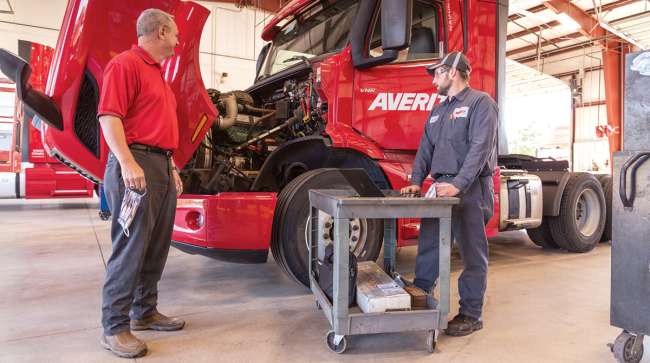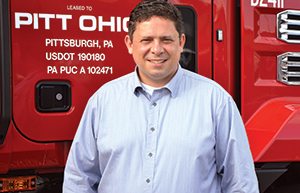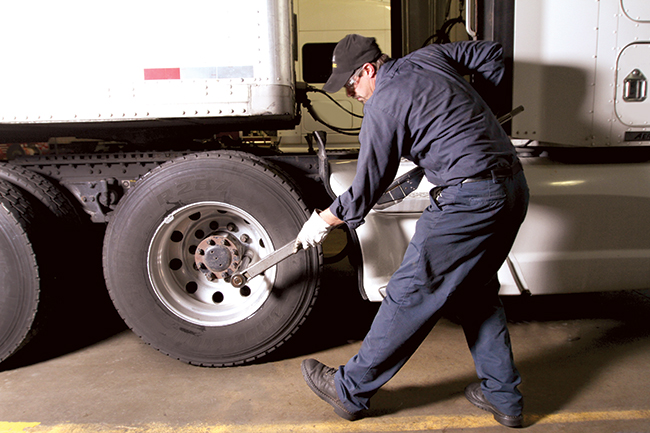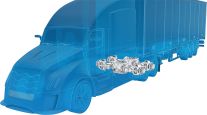Special to Transport Topics
Outsourcing Repair: Fleets Look to Third-Party Maintenance Services

[Stay on top of transportation news: Get TTNews in your inbox.]
With the increased volume of OTR shipping and the rising average cost of new and used Class 8 diesel trucks, the importance of scheduled and emergency maintenance practices remains crucial.
Despite a shortage of trained technicians, the industry’s maintenance service providers — from independents and major truck stops to the fleets themselves — are noticing that the miles between unscheduled roadside repairs are also moving higher.
In a report issued in September by TMC/FleetNet America Vertical Benchmarking, fleets’ miles between unscheduled roadside repairs increased 7% in Q2 2021 to 31,638 miles from the average 29,506 miles in Q1 2021.
Regional carriers such as Pitt Ohio, which serves primarily the Mid-Atlantic and the Midwest, prefer to keep their scheduled maintenance in-house. Trucks leave one of the 21 regional terminals making deliveries between facilities, then undergo maintenance for the next day. Pitt Ohio ranks No. 48 on the Transport Topics Top 100 list of the largest for-hire carriers in North America.
“Freight volumes are challenging,” said Taki Darakos, vice president of vehicle maintenance and fleet services for Pitt Ohio. “There’s a lot of business, but the challenges come from being short-handed on techs, drivers and dock workers.”

Darakos of Pitt Ohio notes that its in-house shop keeps it in control of repairs. (Pitt Ohio)
He said Pitt Ohio’s freight volumes recovered in August 2020 from COVID-19 and have not slowed down, noting new OEM delivery delays caused by the microchip shortage. Darakos explained that longevity of its vehicles comes from the work done in its engine rebuild shop.
“We keep equipment longer and we have trucks that can get up to the million-mile range,” he said. “We are more in control of our repair work.”
When it comes to emergency roadside assistance, fleets have found allies in the major truck stop chains. Homer Hogg, vice president of truck service for TravelCenters of America (TA), labels the truck stop “the heart and soul” of the fleet industry.
“We consider ourselves the emergency room on the highway and our goal is to get the vehicle back in service in a timely way,” he said at the Advanced Clean Technology Expo in Long Beach, Calif., in September. Hogg said, for emergency service, TA relies on service-provider network partnerships of call and rescue vehicles to troubleshoot the causes of a roadside emergency.
“We have a network of partnerships to dispatch service that ultimately will restore uptime and get the vehicle back on the highway,” he said. “We are proud of our service-provider network. We look to the tech staff in the centers to focus on uptime.”
He noted that fleets and drivers are under pressure on hours of service. “When their vehicle comes into our service centers, we try to trim minutes and seconds off the repair time while maintaining high levels of quality and efficiency,” Hogg said.
Third-Party Assistance
Some fleets see third-party providers as a needed and welcome quick fix for light maintenance when out on the road and in need of light repairs.
Doug Lloyd, director of maintenance at Averitt Express, a regional LTL carrier serving 18 states primarily in the Southeast, explained Averitt’s rationale for third-party service providers. Based in Cookeville, Tenn., Averitt Express ranks No. 36 on TT’s Top 100 for-hire carriers list.

More Q4 Calibrate Stories
►Proper Lighting Gives Fleets Brighter Maintenance Outlook
►Scholarships Bring Opportunities to Students Looking for a Sustainable Career Path
►Single Drive Axles Could Reduce Your Fuel Bill
►2022 Is the Year of Research and Discovery for TMC and Its Partners
►Freeze: Trucking Again Shows It Is a Resilient Industry
“Third-party fleet services are very important at our non-Averitt shop locations,” he said. “We use these services for all quick repairs such as tires and jump-starts.”
Lloyd explained that high-dollar repairs at non-Averitt shop locations are evaluated to determine if the equipment should be towed to an Averitt shop for service.
He said that third-party services are cost-effective at non-shop locations and breakdown scenarios and that they are just over 18% of Averitt’s total maintenance cost.
Another choice fleets have for scheduled and emergency service is a specialized third-party service provider such as Dickinson Fleet Services, whose core business is scheduled maintenance with large fleets including DHL, U.S. Xpress, Cardinal and others.
Dickinson has 300 mobile service trucks that routinely work out of the fleet customers’ terminals performing scheduled maintenance during off hours. Mike Dickinson, executive officer of the company, says his company’s service provides ease of use for its customers.
“When servicing the vehicles for scheduled maintenance, we work around the customer’s schedule,” he said. “That eliminates the need for a driver and a chase driver on emergency calls. The tech knows what’s wrong with a vehicle, has visibility to the entire fleet on his tablet and knows the driver’s habits.”
Dickinson said that his company is not affiliated with OEMs or national truck stops, noting it typically doesn’t get emergency calls for roadside assistance from truck stops. In 2019, the fleet service opened FleeTec Training Academy in Florida and plans to open a second training facility in Phoenix this month.
Dickinson said the company developed the training academy to bring people into the truck tech industry. He said the two academies will produce approximately 150 techs per year for the Dickinson workforce, and plans to open a third academy in the Southeastern U.S.

Third-party maintenance services, such as TravelCenters of America, aim for quick and high-quality repair service. (TravelCenters of America)
Another source of nationwide third-party emergency assistance is Love’s Travel Stops with more than 400 locations in 41 states and three third-party emergency call centers
“It’s a growing business for us,” said Gary Price, executive vice president of truck care operations. “We handle breakdowns, preventative maintenance, DOT inspections and tires.”
Price said that vehicle breakdowns often turn out to be routine tire issues. Recognizing the shortage of trained technicians to work on both tractors and trailers, several of these companies are investing in attracting, training and retaining qualified technicians.
Price outlined Love’s training program that starts at an apprentice level with changing tires, moves to preventative maintenance training starting with fuel filters and encompasses the whole truck. At the Level 2 designation, trainees are ready to go on emergency road service calls.
The Level 3 training involves all aspects of a Department of Transportation inspection. From there, the trainee goes into another six-month apprentice program to become an ASE mechanic or a diesel engine mechanic.
In those programs, trainees learn how to work on HVAC, brakes, wheel seals and electronic systems taught by an ASE-certified technician. Also, the apprenticeship program allows diesel tech students to earn a competitive wage as they work toward their designation without the burden of financial debt. Price added that Love’s recruits from the armed services for veterans exiting military service, from trade school graduates and from graduating seniors in high school for the apprentice technician program.
Hogg, of TA, who was also a training infrastructure manager at Ryder System, said training starts the first week for a new tech with an introductory e-learning module. The second week they are introduced to a mentor who works with them for several weeks before they are admitted to the formal training program.
“The entire training program lasts 16-18 months and continues with some training and e-learning modules to stay current and keep up with technology,” he noted.
In the current economic climate, Hogg stated, there’s pressure on the techs and on management to recruit, train and retain techs.
“With the variety of technology on today’s Class 8 trucks, especially with alternative energy and how to treat hydrogen, electric and renewable natural gas-powered trucks,” he said. “We need to keep the techs current in the evolution of technology and the pace of change.”
Want more news? Listen to today's daily briefing below or go here for more info:




